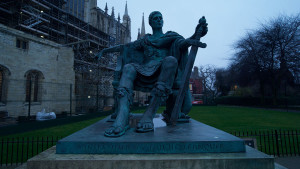His father and grandfather were barrel makers and each bore the same name—Claus Butzer, but history introduces him as Martin Bucer. Regardless, you may still never have heard of him, even though he was a significant figure in the Protestant Reformation of the sixteenth century.
Bucer was born in 1491 in Sélestat, a small town 40 kilometres southwest of Strasbourg, in the free imperial region of Alsace, which at the time was part of the German area of the Holy Roman Empire. During his childhood, he attended a prestigious Latin school and at the age of 15, joined the Dominican order. While he was not particularly fond of the monastic life, the Dominicans were famous for offering a thorough education. Bucer claimed in later years that his grandfather had forced him to join the order. After taking his vows, he was ordained as a deacon and eventually as a priest.
In 1517, the year Martin Luther nailed his 95 Theses to the door of the church in Wittenberg, Germany, Bucer was a student at the University of Heidelberg. The following year, he met Martin Luther and after becoming convinced Luther was right, he asked to be released from his Dominican vows. His wish was granted. In 1522, he met and married Elisabeth Silbereisen, a former nun, making him one of the first Reformers who had been a priest to break their vow of celibacy.
Bucer’s acceptance of Luther’s doctrine and his marriage brought him into extreme disfavour with the Catholic Church. However, for two years he had the moral and financial support of a powerful knight by the name of Franz von Sickingen, who encouraged him to study at the University of Wittenberg. Bucer accepted the offer, but on the way to Wittenberg, he stopped at a city called Wissembourg, where he was asked by the town’s leading Reformer, Heinrich Motherer, to be his chaplain. Bucer accepted the appointment and preached every day.
Writing out one’s “heretical” beliefs was dangerous in those times. Nevertheless, Bucer wrote six theses and the common people accepted his views enthusiastically. This threatened the church’s leadership, so Bucer was excommunicated. To make matters worse, his supporter Sickingen was killed in a battle, leaving Bucer vulnerable, both because of his religious beliefs and because he now had no means of financial support.
As a result, in 1523, Bucer fled to a town called Strasbourg, which by this time had become a strong supporter of Luther’s Reformation. In Strasbourg, he became chaplain to a Reformer named Matthew Zell. The city also granted Bucer citizenship, which gave him a degree of protection.
When the city council asked the Reformers to provide an official statement of their beliefs, Bucer responded with 12 articles summarising the teachings of the Reformation. In these articles, he defended justification by faith and rejected the Mass, the veneration of saints, the doctrine of purgatory and the authority of the pope.
Bucer was an early advocate of ecumenism—setting aside secondary doctrinal issues in favour of church unity. One of the chief issues that divided Protestantism at the time was the meaning of the bread and wine in the Communion service. In Catholic theology, the bread and wine are the literal body and blood of Christ, and the Mass is a re-enactment of Christ’s death. While Luther denied that the emblems were Christ’s literal flesh and blood, and while he opposed the idea that the Mass was a re-enactment of the Cross, he believed that the bread and wine held Christ’s real presence. On the other hand, Ulrich Zwingli, the leader of the Reformation in Switzerland, believed that Christ was only symbolically present in these emblems.
While Bucer personally accepted Zwingli’s teaching that the bread and wine contained Christ’s body and blood only in a symbolic sense, he felt that this was a secondary issue. He viewed both positions as acceptable within the broader Protestant movement, as long as both sides were united on the fundamentals of the faith. Most important to him was that everyone adopt a “child-like faith in God.”
In 1529, Luther, Zwingli and Bucer met with others of the Reformation at Marburg in an effort to resolve their theological differences. They reached agreement on most points, but Luther refused to compromise his position on Christ’s presence in the bread and wine. At the close of their discussions, he concluded that “it is obvious that we do not have one and the same spirit,” and no agreement was made.
Bucer was opposed to the worship of images, but he tolerated it as long as the people did not venerate them. He agreed with an action of the Strasbourg city council in 1530 to remove images from the city’s churches, provided the people were also properly instructed to abandon their devotion to them.
Bucer was also anxious to bring moral discipline to the church in Strasbourg, so he had wardens chosen from among the laity to supervise doctrine and practice in each church. One of his main motivations for doing so was the fact that Strasbourg had become a haven for people who accepted the Reformation and among those who sought refuge in the city were radical Reformers who opposed not only the church but government and social order as well. Bucer vigorously opposed these ideas, insisting that the city council assume control over all Christian worship.
Bucer is considered one of the great leaders of the Reformation in Germany. Following Zwingli’s death in 1531, Bucer was regarded as the foremost Reformation leader in southern Germany and Switzerland. John Calvin used many of his ideas.
Unfortunately, despite his success or perhaps because of it, Bucer’s position in Strasbourg came under threat. Both Philipp Melanchthon in Wittenberg and John Calvin in Geneva invited him to join them. However, he had corresponded for a number of years with Thomas Cranmer, the archbishop of Canterbury, and when Cranmer offered him a position in England, he accepted. There he assisted with the second revision of the Anglican Book of Common Prayer and wrote On the Kingdom of Christ in which he urged King Edward VI to make England a completely Protestant country.
Bucer eventually became a professor of theology at Cambridge University, where he died in 1551. He was buried in the Church of St Mary the Great, but his body was not to rest in peace. When the staunch Catholic queen Mary ascended to the British throne, she ordered his body exhumed and publicly burned along with his books.
However, the final chapter of Bucer’s life was written after his death by the Protestant queen Elizabeth I, who succeeded Queen Mary. She had his name rehabilitated in 1560, ending the story of this lesser known but nevertheless influential and courageous Reformer.




